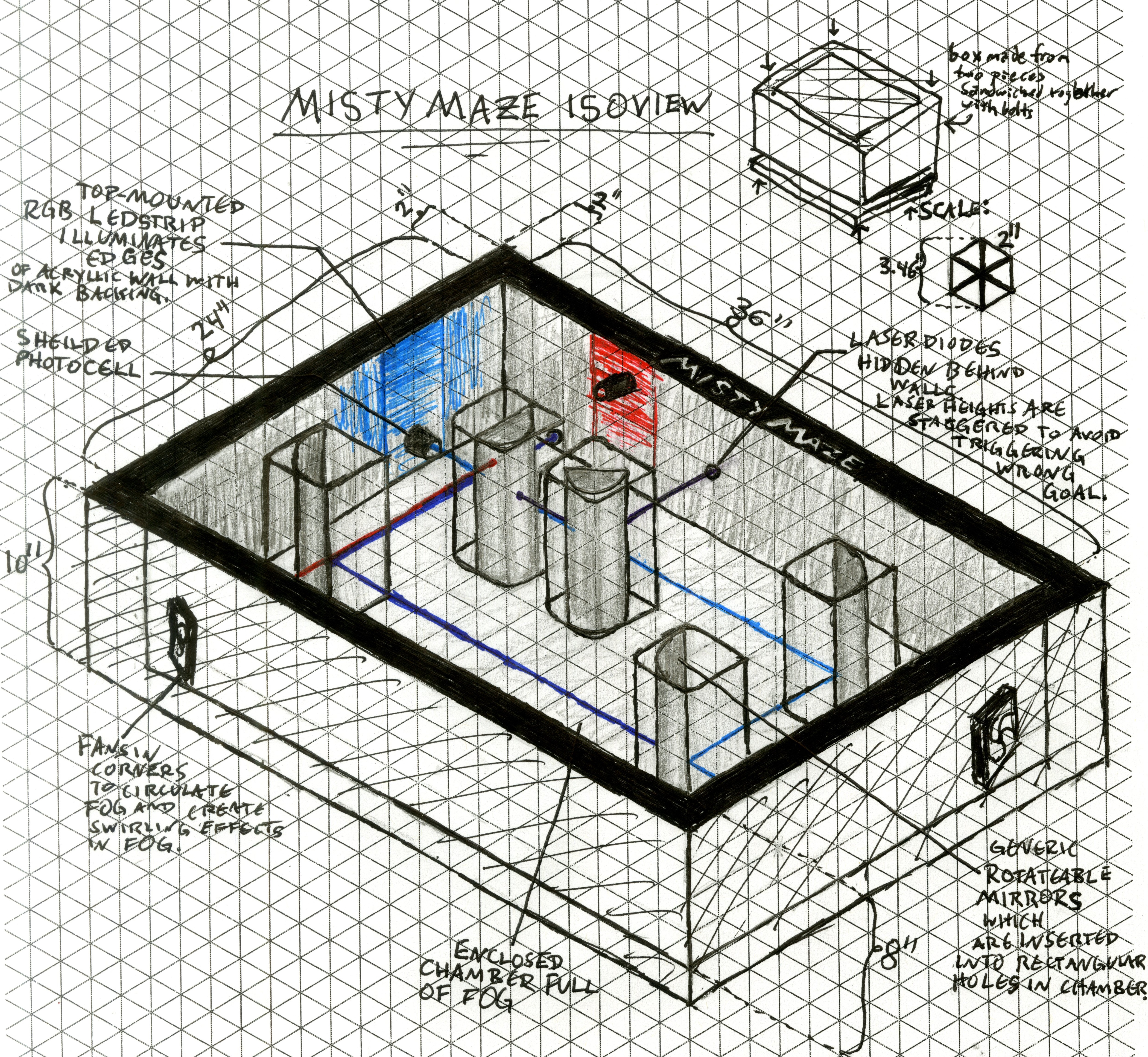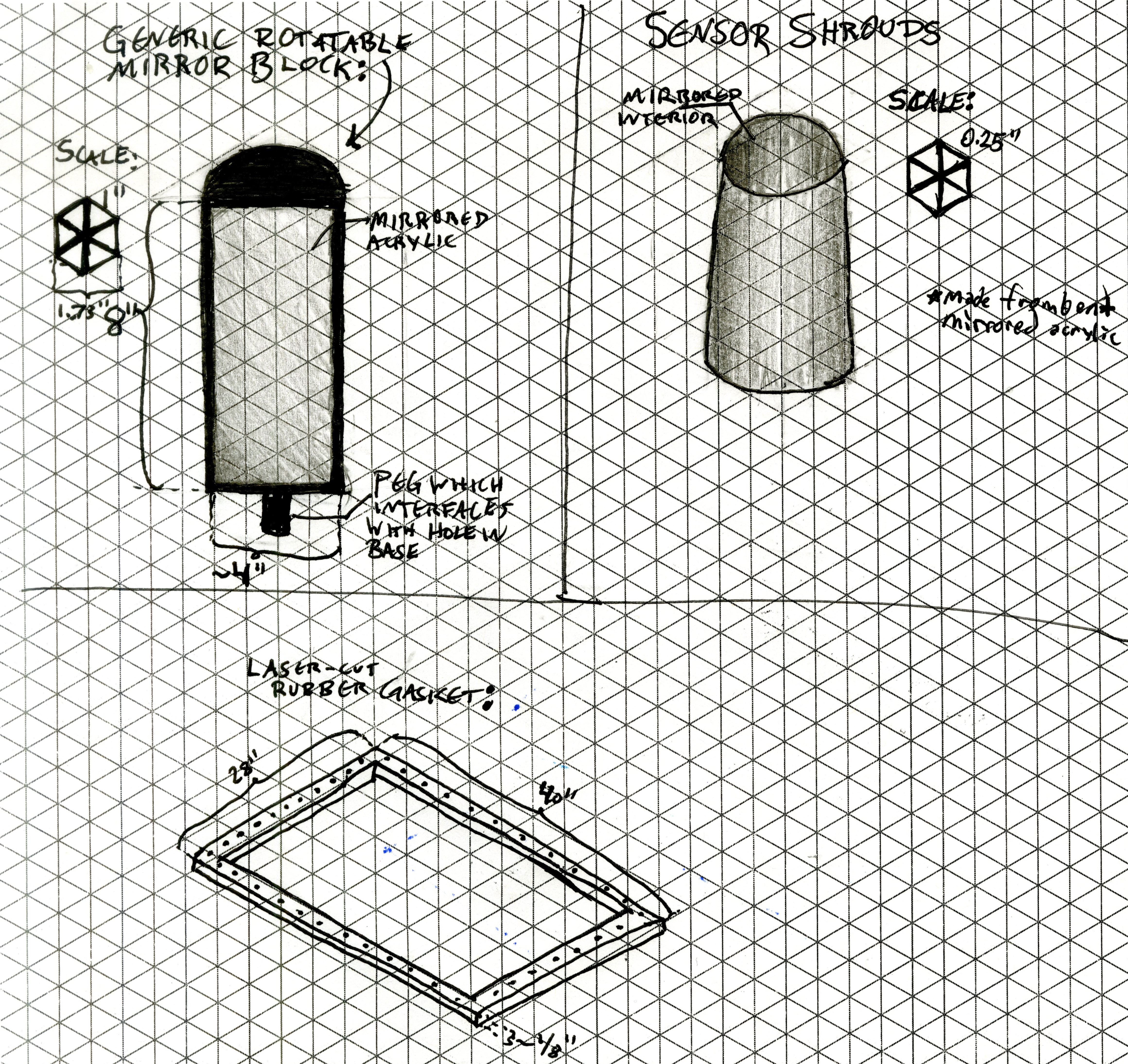Summary:
The Misty Maze is a wondrous interactive experience where the user attempts to redirect laserbeams to specific targets using adjustable mirrored blocks.The “laser obstacle course” will be encapsulated in a fog filled enclosure where the fog both highlights the lasers’ path as well as is in constant motion to add to the mysterious atmosphere. Once the one of the lasers reaches its respective target a large addressable LED strip within the enclosure lights up the laser’s color and helps color the fog further. As this exhibit is heavily dependent on light, it would be best if it was placed in the darker hallway between the Attic and the Garage so that its visual aspects are more evident. A typical interaction would ideally involve the visitors being drawn in by the swirling fog and intricate laser patterns and then, through the solving of a simple puzzle where the mirrored block must simply be removed, figuring out that the lasers can be redirected and attempting to hit the intended targets. Ideally this solution would involve the visitor having to rearrange various mirrored blocks and rotate them various ways; however, there would be multiple paths to the target so that more intricate patterns can be created. When the target is hit the tank will add its respective laser color to the fog and incentivise the visitor to hit all the other targets to add more and more colors to the mix. We would consider this project a success if the visitors are able to figure out the light puzzle and the incentive of adding various colors to the swirling fog causes them to continue to interact with it.
Technical Outline:
Summary:
This system is ultimately composed of lasers being pointed at photoreceptors. The lasers and fans inside the fog chamber are powered by a single pair of wires controlled by an arduino outside of the chamber with a relay. The photo-receptors will be placed outside of the chamber and read by the arduino.
Materials, Structure, and Mechanism:
The structure consists mostly of a sealed chamber containing fog with several sealed pass-through holes in it which allow for the insertion of manually rotatable mirrored blocks. Additionally, there may be one or two actuated mirror blocks which rotate on their own in a region which is accessible by several of the lasers but not in the target path of any of the lasers.
The chamber will be made from laser-cut clear acrylic with a double wall on the perimeter. This double wall will be assembled with acrylic glue to the top pane to create a U-shaped air-tight piece. This piece will be sandwiched against a flat base-plate with a laser-cut “rubber” gasket in the middle to create a resealable airtight chamber.
Each of the pass-through holes will be made from a single heat-bent sheet of acrylic to minimize the length of edges which could leak fog and acrylic-welded to the top piece.
The mirrored blocks will be made from a 3D-printed shell with an arbitrary, seemingly random, faceted shape with several inserts of laser-cut mirrored acrylic.
Sensors, Actuators, and Algorithms:
The primary sensors will be photodiodes. The signal from these diodes will need to be first run through a low-pass filter to remove the considerable noise which will be induced by light diffracting through the fog. The result of this filter over a short period of time during setup will then need to have its maximum determined to set a threshold for determining if the laser-light is incident on the sensor. Any actuated mirrored-blocks will be controlled by a basic DC motor and H-bridge driver.
Key Technical Challenges:
By far, the biggest technical challenge is ensuring that the fog doesn’t condense on the top pane of acrylic, occluding the user’s vision of the effect. This can be accomplished by ensuring that the air is properly circulated and that the temperature of all air near the top surface remains above the dew-point of water (~60 degF). Ideally this will be accomplished by simply circulating the air fast enough and loading in new fog at an appropriate rate; however, if this were to fail, hot air (from a hair-dryer) would need to be gently blown across the inside of the top surface. Which of these solutions will be necessary will be determined by the construction of a small scale proof-of-concept chamber.
Time and Budget Outline:
In order to complete our project we will require some special items, most notably the fog machine and the laser pointers. Additionally we will need a decently large amount of acrylic to create the enclosure for the lasers and fog. A full Bill of Materials can be found on our project schedule . Overall our cost is estimated to be around 140$. As of now we are unsure on what our budget from the class will be; however, if we need to help offset costs we will only use the 3 laser pointers and attempt to locate a fog machine we can borrow for testing and the demo dates. Additionally we should be find acrylic from other sources to offset our costs. In the case that we must pay out of pocket we will split the costs evenly between the two of us.
Project Management:
The design of Misty Maze will be conducted by both Michael and Connor; however, Connor will primarily handle the software and electronics while Michael will be responsible for fabrication and assembly.
During our initial proof of concept test we will have two main categories to test: the structure of the tank and the abilities of the laser/LEDs. For the tank, we need to ensure that it keeps the fog fully contained inside while also allowing us to easily circulate the fog. For the lasers we need to be sure that they are powerful enough to be seen in the fog and pass through the acrylic layers and can be redirected by the lasers. The LEDs must also be tested to observe if they have the intended effect of lighting up the fog and mixing the colors in a pleasing way.
When we first test the Misty Maze at the Children’s Museum we should ideally have everything working and will focus on seeing how the visitors interact with the exhibit as a whole. Specifically we will look for:
- Is the puzzle easy to understand
- Is it intriguing enough(does it draw in the visitors)
- Is the addition of light to the LED strip enough of a reward/incentive
- How do they try and break it
While we have thought out many aspects of our design there are some parts of it which we cannot decide until we see if it will be an issue. For instance we are unsure if the fog will cause the acrylic to fog up and if this is the case we will adjust the circulation in the tank and add in new air or blow hot air within the tank to prevent fogging. Additionally if we find that the fog obscures the lights more than we expect we will also have to opt to not using the fog. Finally, if we discover that that the light sensors in the lab are unable to pick up on the laser’s light due to it being a focused point we will either have to attempt to disperse it before it reaches the sensor to get a better reading or buy a color sensor instead.


Leave a Reply
You must be logged in to post a comment.